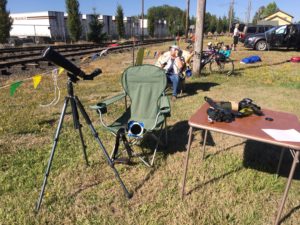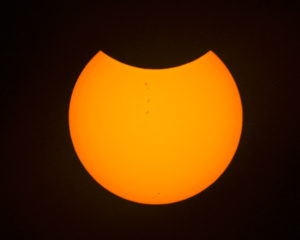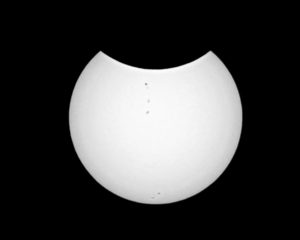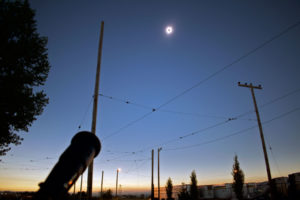I went out to Oregon recently to visit my father-in-law, but I had an ulterior motive as well: he lives on Chehalem Mountain, right above the town of Newberg. The town is just a few miles south of a great airport (Portland International), but—more importantly for my purposes—only a few miles north of the zone of totality of the August 21 solar eclipse that spanned the country. It was a short drive from his mountaintop balcony with “only” 99.98% obscuration to one of the many pop-up campgrounds in the path of 100% coverage.
Totality was scheduled to last 1 minute 40 seconds at the campsite, and I suppose it did, although like nearly every eclipse observer ever, I felt like it was about 7 or 8 seconds, tops.
I had come loaded for bear: two cameras, one with a long lens and solar filter, the other with a wide-field lens and intervalometer to try my hand at the “progression” of the eclipse from first contact to totality to last contact. Unfortunately, I hadn’t realized that my wide-angle lens did not have a manual focus ring, so that setup was useless except for a quick “mood shot” during totality, when I’d have been better served snapping shot after shot with the telephoto.
Here’s a snapshot of the setup:

The main observational scope was my 60-mm grab-and-go scope fitted with a homemade solar filter. I’d been so excited to build the solar filter, because I had a full sheet of what I’d thought was Baader planetarium solar film (the label on the protective cardboard sheets said BP) but turned out to be Thousand Oaks optical solar film instead. Much denser and harder to see through, and it turns the sun orange instead of that lovely flat white of the Baader film. Oh, well.
My binoculars had a pair of old Baader filters that I’d made back when I was living in Los Angeles, and those showed me the nice white sun that I’d been anticipating. I also tried to use that setup for my wide-field camera, but there wasn’t enough for the autofocus to grab hold of, and so none of the partial eclipse photos came out with that rig.
So most of my photos were with my 500mm Nikon lens (actually the 200 to 500 zoom, but I almost always keep it cranked over to 500), and they’re orange:

And that’s basically what I saw for most of the eclipse.
A much more aesthetically pleasing image can be achieved with some minor work in Photoshop. In the image below I desaturated to get rid of the orange, then bumped up the exposure to make it brighter, and finally I increased the gamma correction so the sunspots would be more visible:

But it’s nowhere near what sticks out in my memory. What I’ll remember forever about this eclipse was how the lights seemed to dim in the minutes before totality, and how it got so dark that I realized I wasn’t able to set my camera controls to bracket (vary exposure time while keeping aperture constant, or vary aperture while keeping exposure time constant) during totality because I rely on seeing the camera dials rather than reading the info through the viewfinder. The crowd at the campsite grew very loud, cheering the arrival of totality, then quiet, awed by the spectacle. And then noisy again, cheering when the sun reappeared from behind the moon.
One of the last images I snapped before totality ended will always define this eclipse for me. In it you can see Baily’s beads at the top of the sun, where the edges of the sun are shining through craters on the rim of the moon, as well as the red prominences of solar flares1 extending off the edge of the sun:

Desaturating that image wouldn’t improve the aesthetics. Why not? Because it was taken during the (very last moment of) totality. No solar filter needed! (Or useful.)
Unfortunately, because I was too busy futzing with my cameras (I even took some time to snap some “mood shots” with my wide-field Nikon)

I didn’t have time to look for the (reputedly) ethereal beauty of the solar corona that can be observed during totality. (In fact, for earthbound observers, it’s almost impossible to view the corona anytime outside of totality. Clever observers can use a coronagraph that occults the sun artificially, but it’s not as effective as the moon during a total eclipse. The most useful coronagraphs are satellite based.)
I managed to snap a few shots of the corona, yay, but nothing as dramatic as the ones experienced eclipse photographers can capture. Here’s probably my best one:

I’m honestly not trying a humblebrag here; I’m disappointed in this image. I was hoping for visible structure in the corona, delicate tendrils and whatnot, rather than just an impressionistic wash. On the full-size image, you can almost see some looping structure at the bottom, unless I’m just imagining it. But I was hoping for much more.
Oh, well. I’ll have more than twice as long during totality on April 8, 2024!
Related Images:
- Technically a prominence is a full loop of solar material (a superhot phase of matter known as plasma, not a “gas”) extending from the surface of the sun out into space and back down again, while a solar flare is a “blowout” explosion; the plasma in a flare does not loop back down to the surface of the sun












